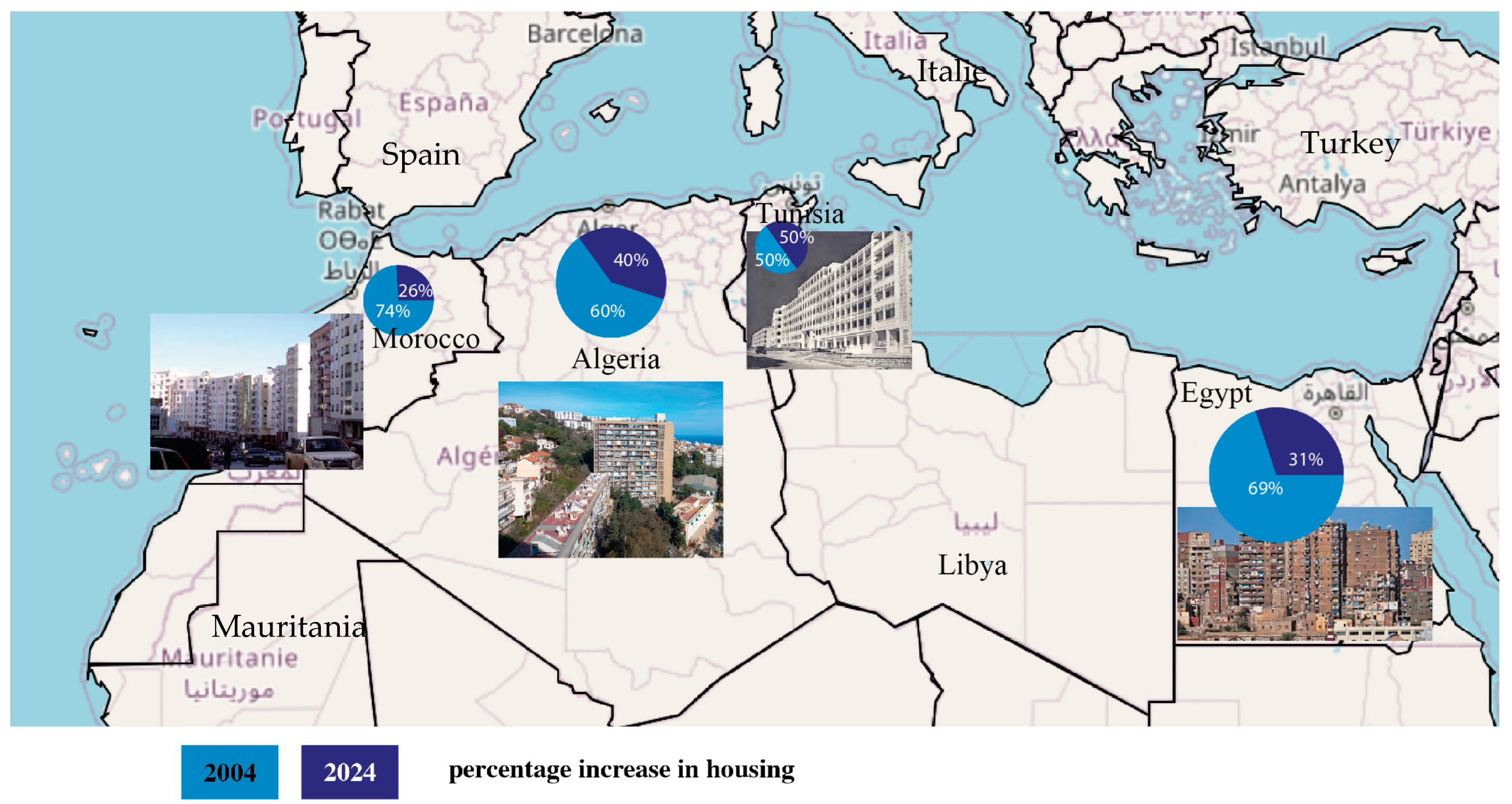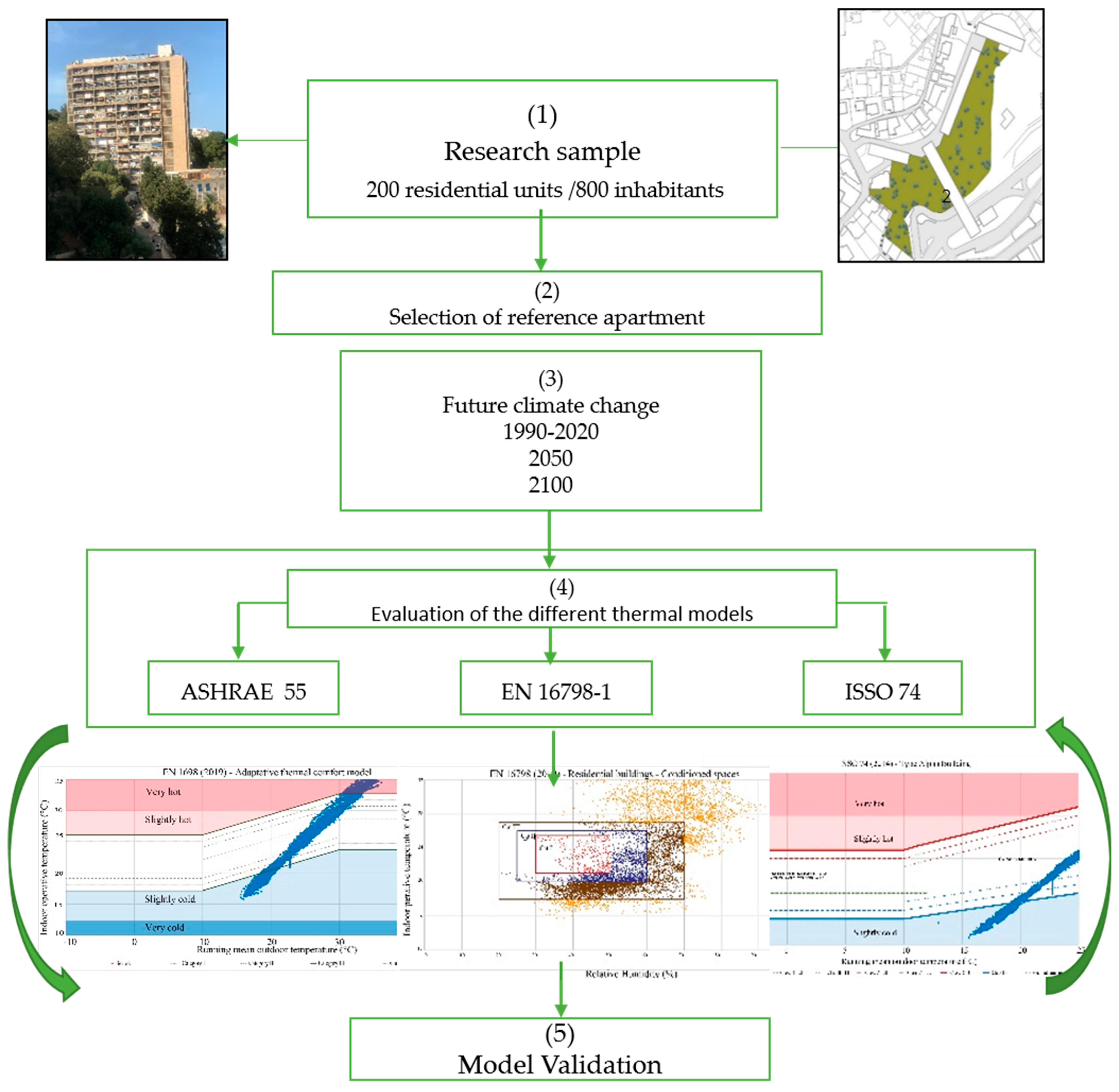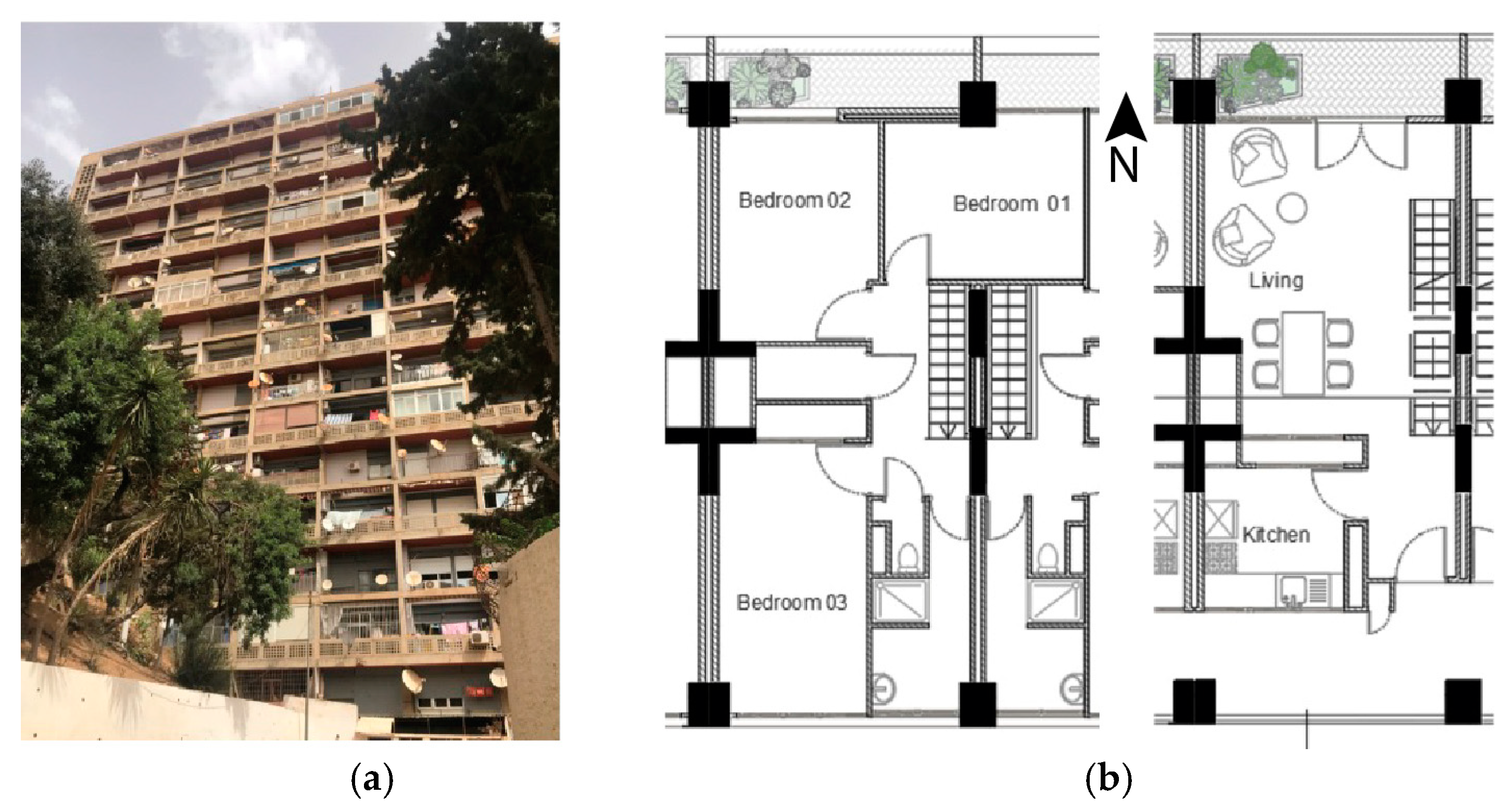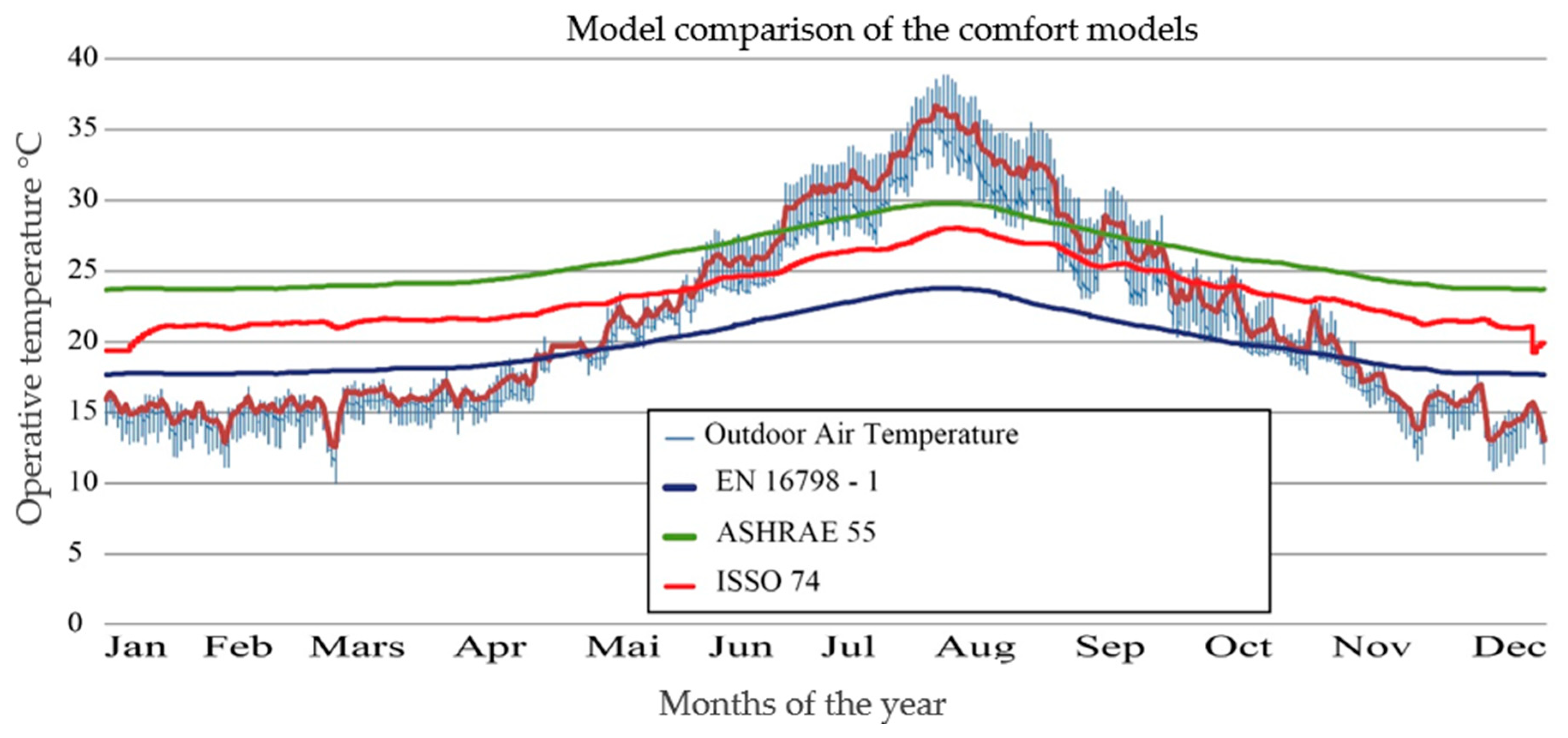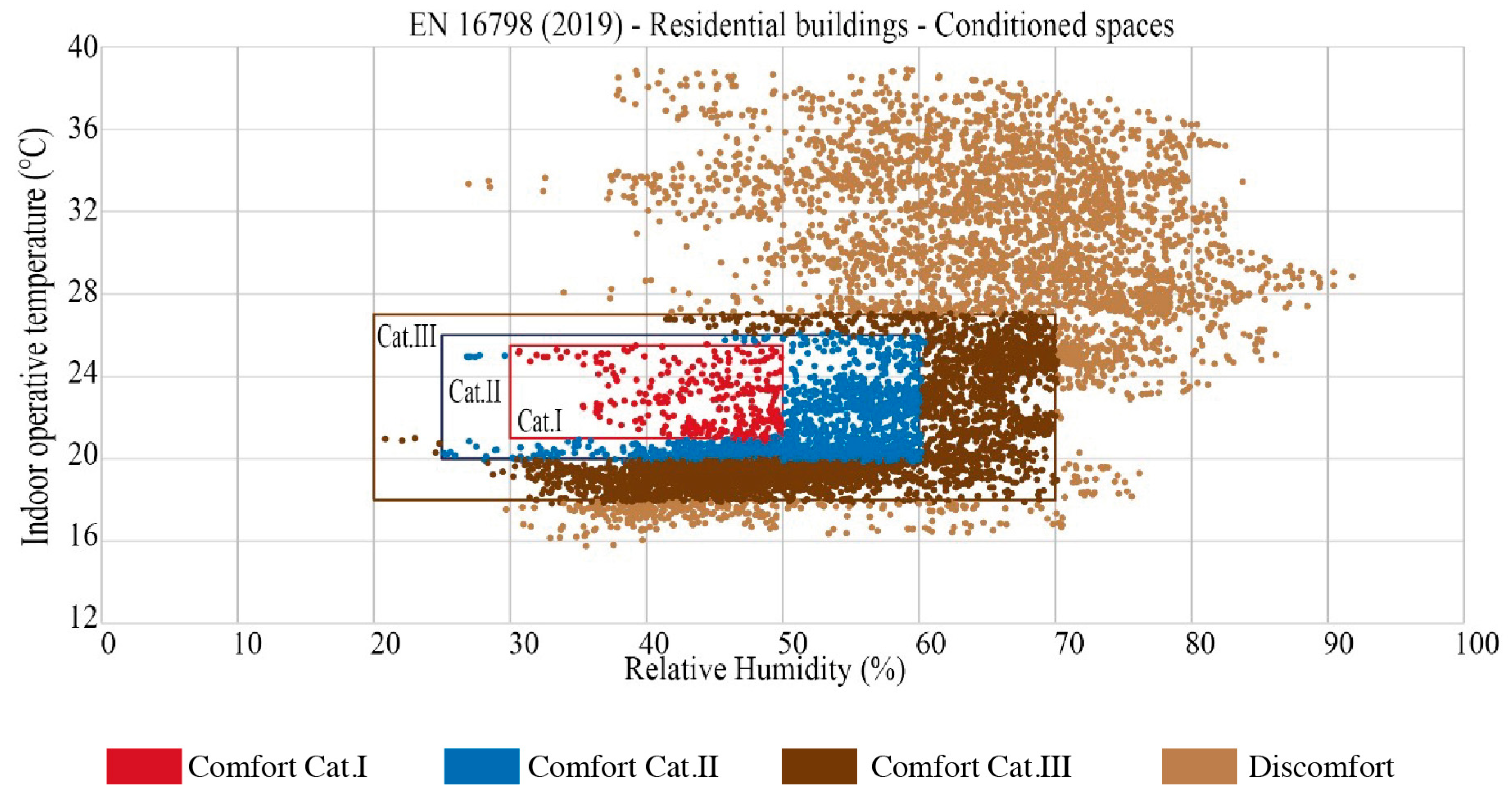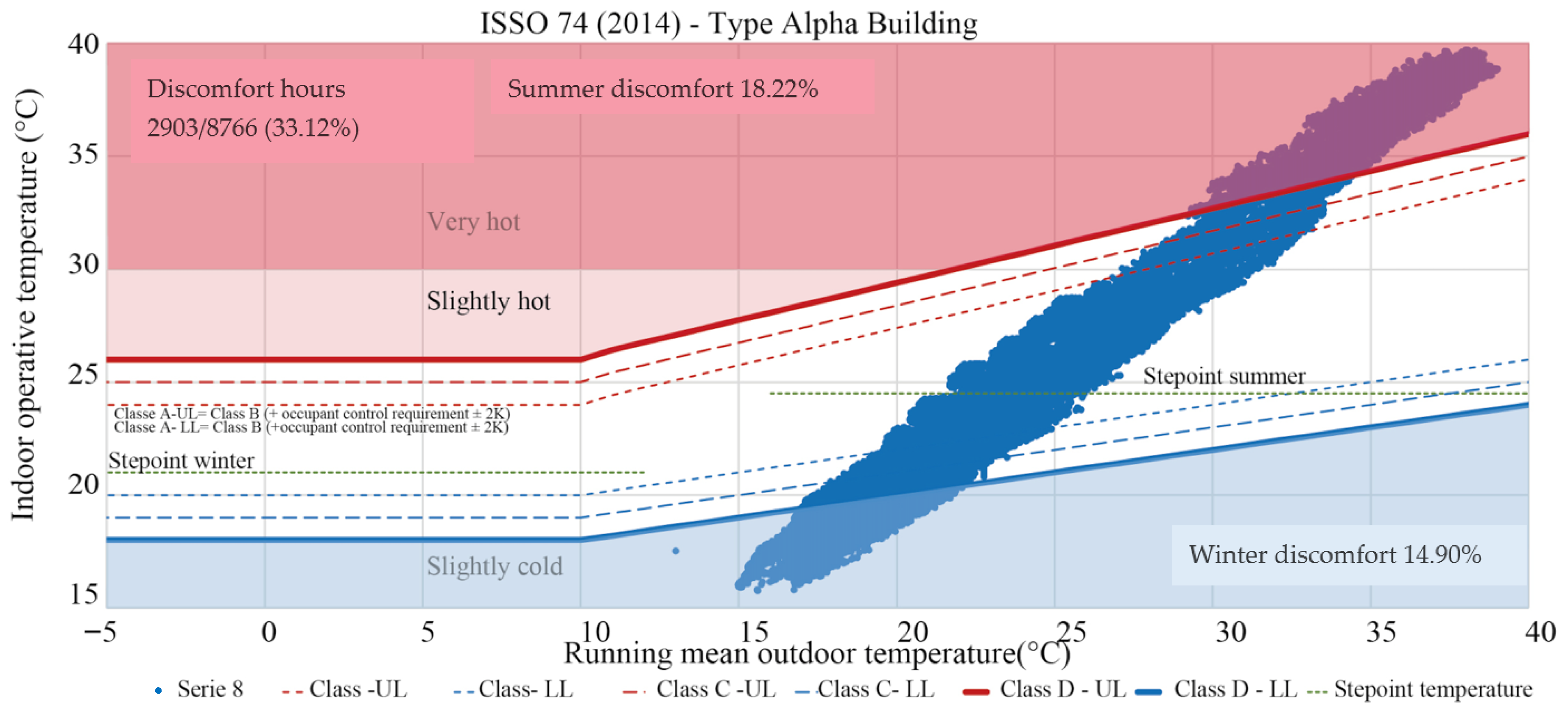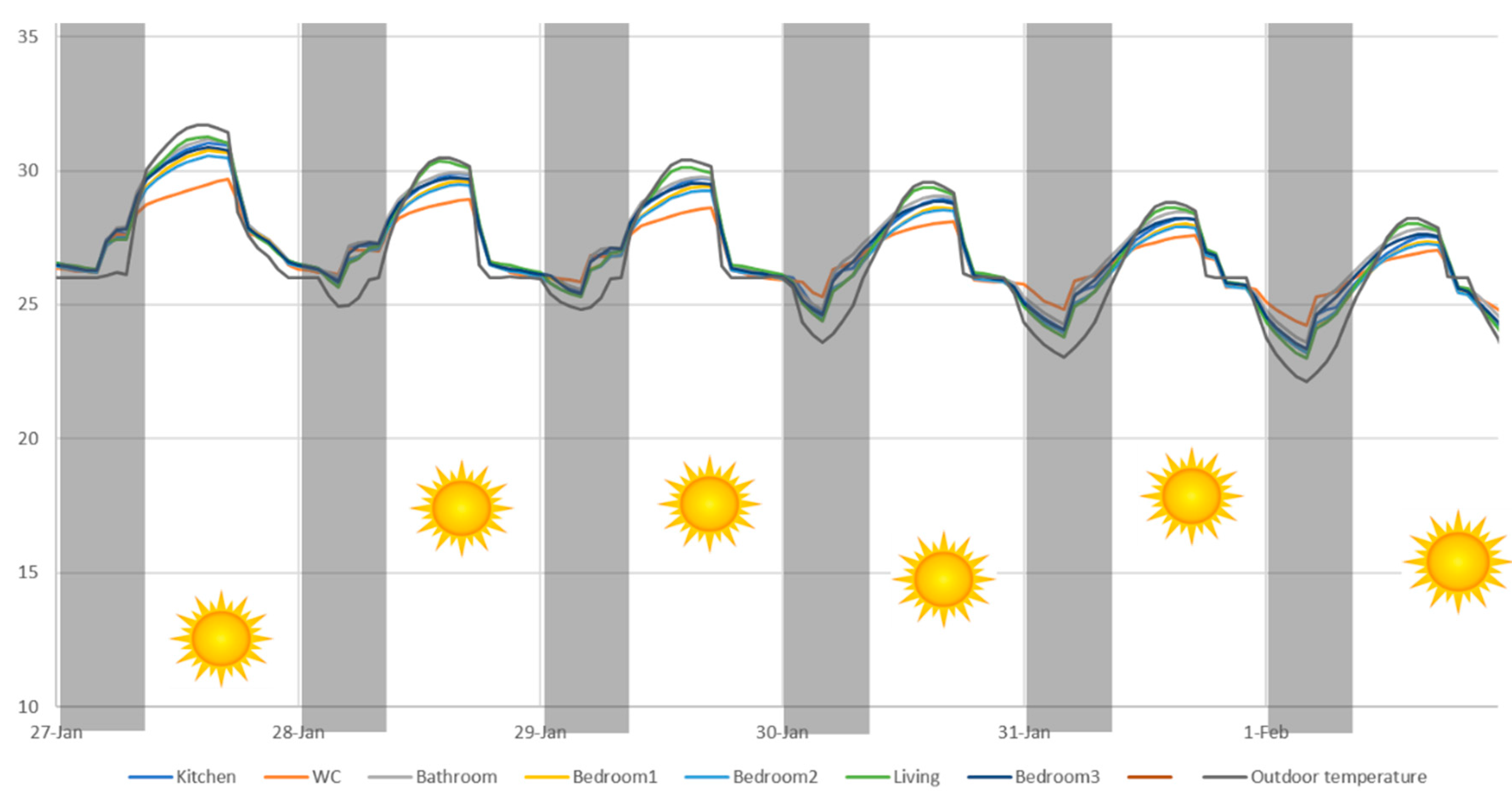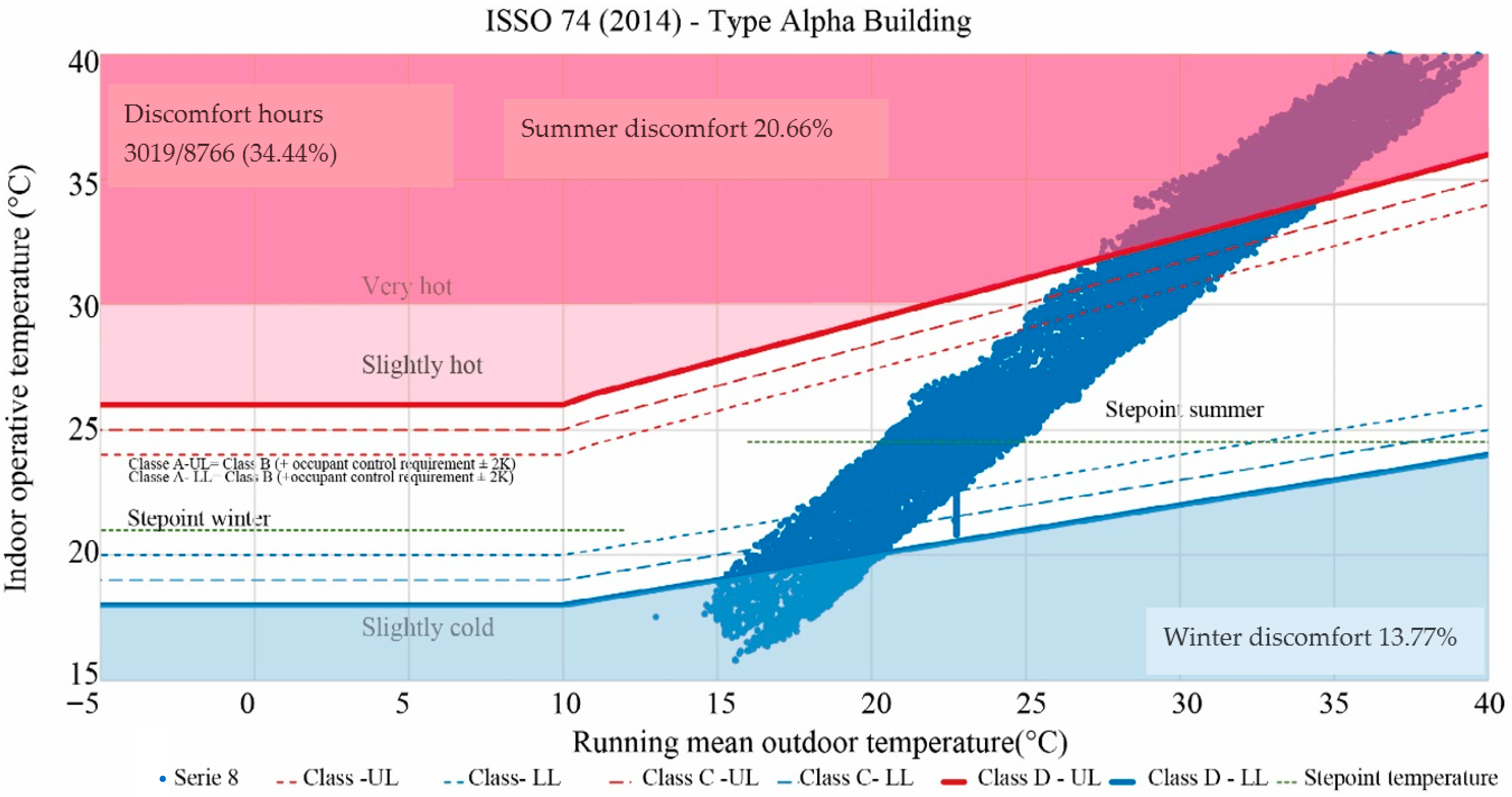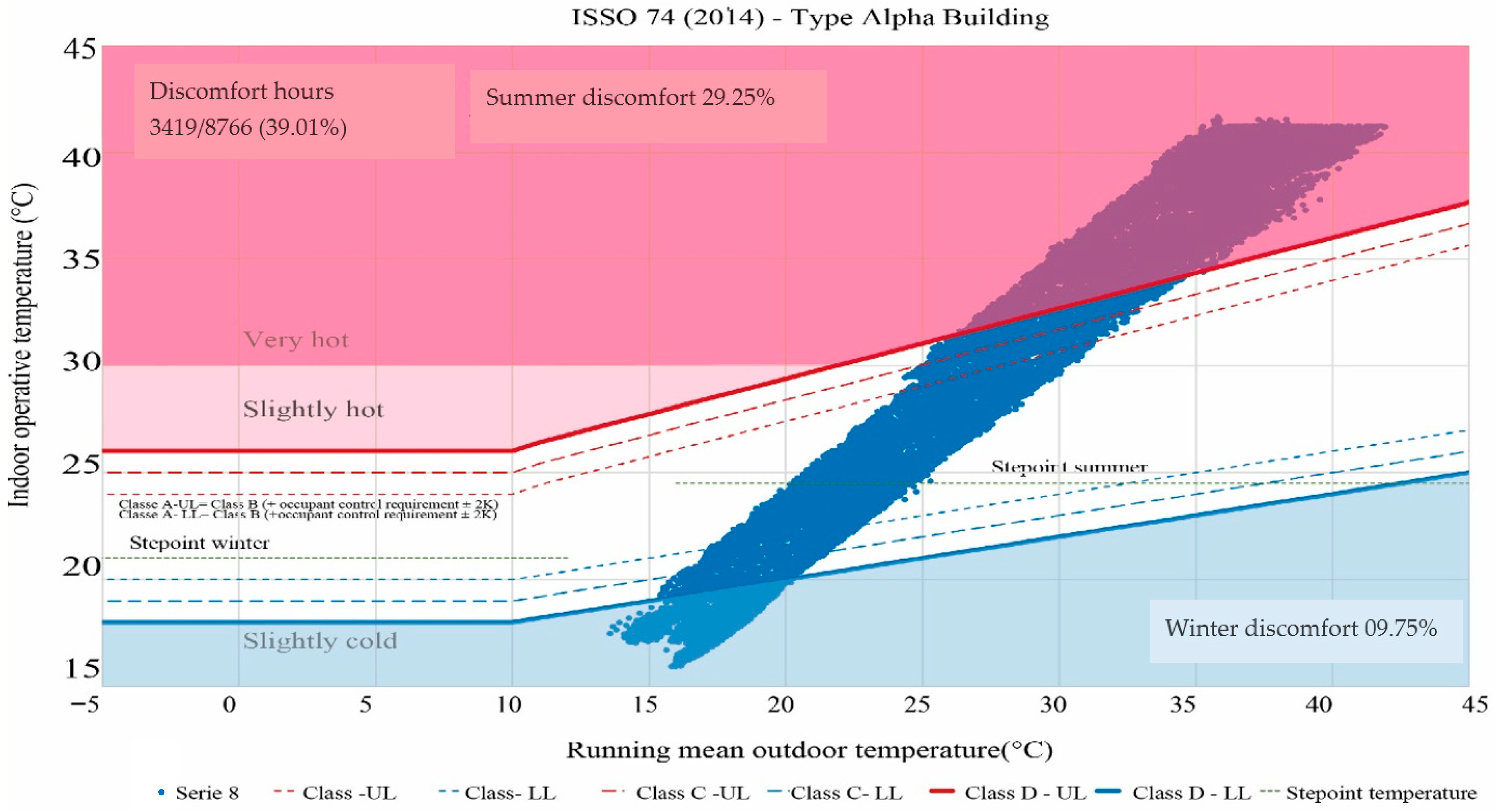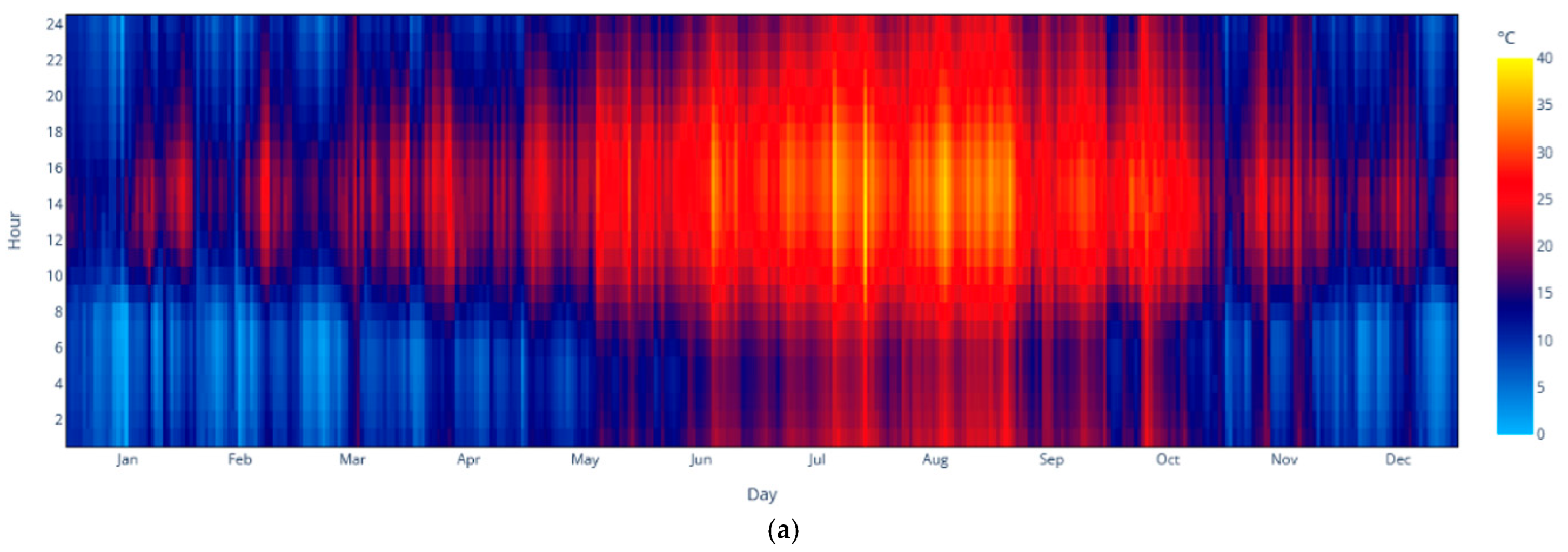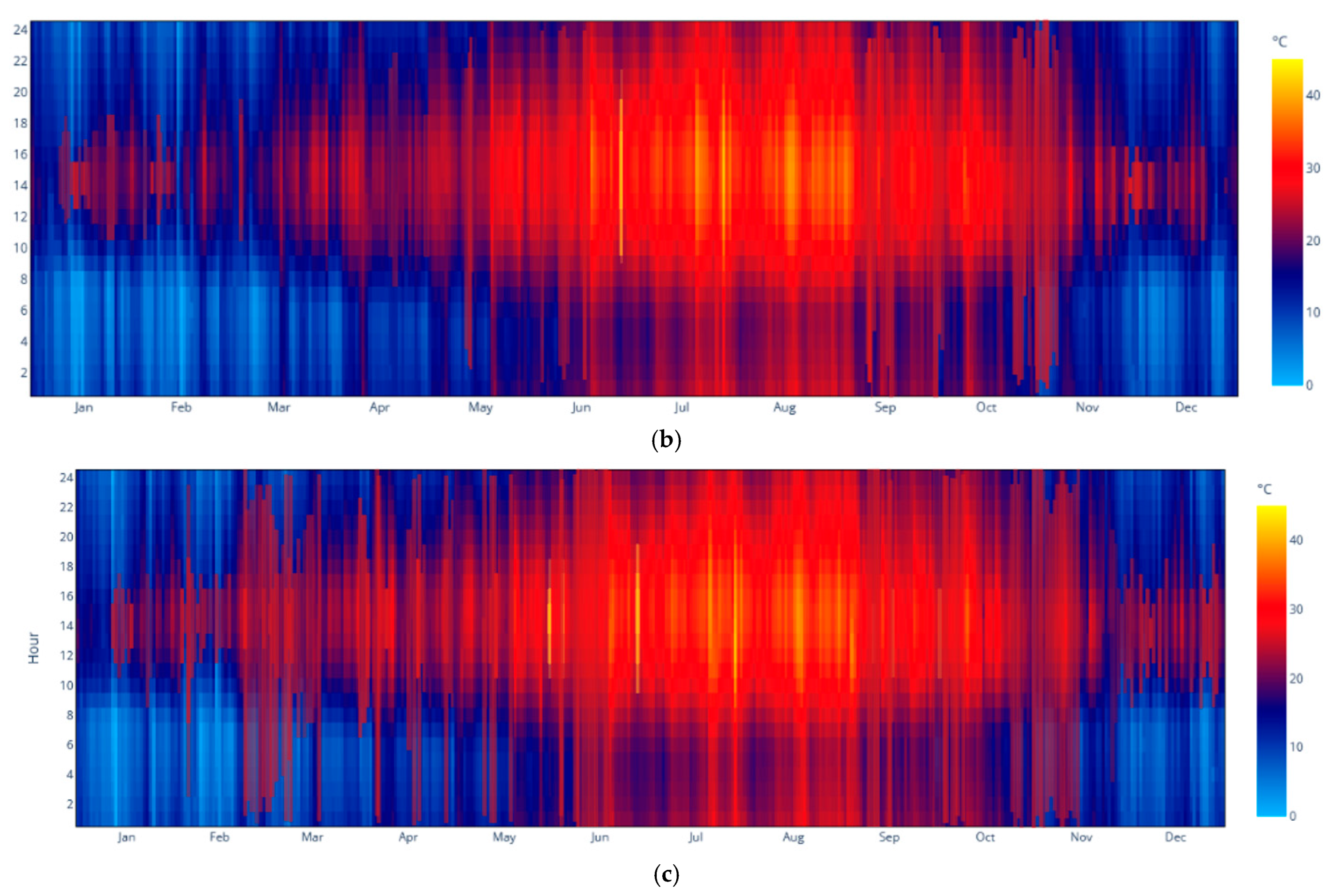1. Introduction
1.1. Context and Problem Definition
In Mediterranean climates, prolonged exposure to elevated indoor temperatures—intensified by climate change—poses a growing risk to occupant health, comfort, and energy systems [
1]. North African countries, including Algeria, are especially vulnerable due to rapid urbanization, limited retrofitting of the existing housing stock, and building typologies that lack passive resilience [
2]. Urban development programs launched in the 1990s sought to regulate land use and mitigate rural poverty, but they failed to prevent unplanned urban expansion in major cities. Consequently, much of the housing stock was developed without systematic assessments of indoor environmental quality, particularly thermal comfort (
Figure 1).
Dense multi-family housing continues to be constructed without climate-adaptive design strategies or formal comfort evaluations, leaving residents increasingly dissatisfied during hotter summers. Integrating thermal comfort into housing policies in cities like Algiers has become an urgent priority. Simultaneously, the Mediterranean region is warming at a rate faster than the global average. Sea surface temperatures exceeded 28 °C in 2024 [
3], with persistent anomalies recorded since 2007 [
4]. Anthropogenic factors account for ~74% of observed increases in seasonal variability [
5]. By 2100, mean temperatures are projected to rise by more than 2 °C, amplifying the risks of extreme heat; for example, Lisbon’s physiologically equivalent temperature could exceed 58 °C [
6].
Although this study focuses on Algiers,
Figure 1 presents housing stock trends between 2004 and 2024 in Morocco, Algeria, Tunisia, and Egypt, highlighting regional patterns and the cross-country relevance of adaptive comfort strategies [
7,
8,
9,
10,
11].
1.2. Knowledge Gaps and Research Focus
Thermal comfort evaluation is central to indoor environmental quality, yet its application in North African contexts remains sparse. Prominent international models include ASHRAE 55 (temperature, humidity, airspeed, radiation, clothing, and activity factors) [
12], ISSO 74 (a hybrid adaptive–static model with seasonal temperature limits) [
13], and EN 16798-1 (indoor environmental parameters for design and performance calculations) [
14,
15,
16]. Despite widespread use, there are no integrated assessments combining these three frameworks with field monitoring, occupant surveys, and dynamic simulations in a Mediterranean climate.
Comparative studies often examine model pairs, such as ASHRAE 55 with EN 15251 [
17], ASHRAE 55 with ISO 7730 [
18], or EN 15251 with ISO 7730 [
15], but they rarely address all three simultaneously. This work presents the first context-specific comparative analysis of ASHRAE 55, EN 16798-1, and ISO 74 for a North African Mediterranean city, utilizing unified datasets to evaluate present-day performance and robustness under high-end climate change scenarios [
19]. The synthesis is particularly relevant for regions facing rising summer temperatures, energy poverty, and recurrent blackouts. In southern Algeria, summer peaks already exceed 50 °C [
20], and cooling demand is projected to double within a decade [
21], thereby stressing grid stability [
22].
1.3. Research Aim and Objectives
The overarching aim is to provide designers and policymakers with validated, context-appropriate comfort assessment tools to inform passive retrofitting and climate-responsive design. This study addresses the following three key questions:
Which comfort model best reflects Mediterranean climate tolerances for temperature and humidity?
How do discomfort patterns vary across seasons, months, and critical heat periods?
What are the projected climate change impacts on residential thermal comfort by 2050 and 2100?
By answering these questions, the work provides actionable guidance for adaptation strategies that reduce over-reliance on mechanical cooling, thereby mitigating the risks of unsustainable energy demand and grid instability.
2. State of the Art
2.1. Scope Definition—Mediterranean Climate and Comfort Challenges
The Mediterranean climate, classified as Csa or Csb in the Köppen–Geiger system [
23,
24], features mild, wet winters and hot, dry summers. Climate change is altering this balance, increasing cooling degree days (CDD) and shifting seasonal comfort thresholds [
25,
26,
27,
28]. Thermal comfort in such contexts is not only a matter of energy efficiency but also a determinant of health, productivity, and resilience. For example, Attia et al. [
29] documented heat stress symptoms during a 19-day heatwave in Cairo, underlining public health urgency. While retrofits can enhance comfort, benefits are often offset by maladaptive occupant behaviors [
26], such as abandoning passive cooling measures.
2.2. Gaps in Classical and Adaptive Models
Classical models such as Fanger’s PMV/PPD and ISO 7730 are embedded in building design practice but rely on data from temperate or continental climates [
30,
31,
32,
33]. This limits their accuracy in Mediterranean conditions, where cultural behaviors, such as greater acceptance of summer heat, clothing adaptation, and natural ventilation, play a critical role [
34]. Adaptive models, such as EN 16798-1 and ASHRAE 55, partially address these behaviors by introducing outdoor temperature-linked comfort bands. However, their validation for Southern Europe and North Africa remains limited, particularly under warm, humid conditions with high seasonal variability.
In the present article, ISSO 74 was selected alongside ASHRAE 55 and EN 16798-1 following a comparative review of model requirements, climate transferability, and dataset constraints. While ISSO 74 originates from the Netherlands, its hybrid approach, which combines adaptive and steady-state principles, offers advantages for climates with pronounced seasonal variability and mixed-mode ventilation, such as those found in the Mediterranean. This framework explicitly defines temperature limits for different building types and seasons, enabling evaluation across both adaptive and conventional comfort ranges. Its inclusion in the analysis is therefore positioned not as a limitation-driven choice, but as a complementary benchmark to ASHRAE 55 and EN 16798-1, supporting a richer cross-standard comparison and enhancing the robustness of the study’s findings.
2.3. Empirical Evidence from Mediterranean Studies
Empirical research demonstrates that occupants in Mediterranean climates accept wider temperature ranges than classical models predict. Al-Saeed El Gindi et al. [
9] and Khechiba et al. [
10] demonstrated that passive measures, such as shading, insulation, and natural ventilation, substantially reduce discomfort hours and energy consumption. In Athens, acceptable temperatures range from 17 to 21 °C in the cooler months to 26 to 32 °C in summer [
35], while studies in Seville [
36], Tunis [
37], and Tangier [
8] have confirmed similar temperature tolerances. Occupants frequently combine environmental and personal adaptations, opening windows, adjusting blinds, and altering clothing, to maintain comfort [
38,
39]. Seasonal acclimatization further broadens tolerance late in summer [
40,
41]. However, few studies integrate high-resolution humidity data into comfort assessment, despite its critical influence in coastal Mediterranean climates. This gap highlights the need for locally calibrated adaptive models that can capture both temperature and humidity effects under evolving climate conditions.
2.4. Research Directions
Despite advances, the following gaps remain:
Lack of Mediterranean-calibrated models integrating climate data and behavior [
42,
43].
Scarcity of longitudinal studies capturing multi-seasonal adaptation [
44,
45].
Insufficient linkage of indoor–outdoor comfort assessments [
46,
47].
Limited integration of resilience metrics for extreme heat events [
48].
Recent studies advocate for mixed-method approaches, combining field measurements, simulation calibrated with real comfort feedback, and participatory design, to ensure model validity under climate change [
29,
49,
50]. These methods are essential for creating robust, context-specific comfort standards for Mediterranean cities.
3. Methodology
We summarized the research methodology of this work in
Figure 2. It is based on five axes, which are described in the following subsections. Previous studies have informed the methodology of this research, including the work of Attia et al. [
51] and Tellache et al. [
52]. In this article, four adaptive thermal comfort models were evaluated, ISO 17772-1 [
53]., ASHRAE 55, EN 16798-1, and ISSO 74, as shown in
Figure 2. These models were selected based on their international recognition and relevance to naturally ventilated or mixed-mode buildings. By applying all four models to the same dataset, we aimed to compare their responses under current and future Mediterranean climate conditions. This comparative approach allowed us to identify the most suitable model for further analysis in the context of residential buildings in Algiers.
The ASHRAE 55 Adaptive model defines comfort ranges based on the prevailing outdoor temperature, with two acceptability categories (80% and 90%). The ISSO 74 model, developed for Dutch conditions, applies narrower comfort limits and seasonal adjustments. The EN 16798-1 model uses three comfort categories (I–III) with more restrictive thresholds, especially in warm conditions. These differences influence the comfort ranges and the outcomes of the comparison.
3.1. Selection of Case Study
3.1.1. Description of the Case Study
A reference building located in Telemly, a district in downtown Algiers, serves as a buffer zone for a UNESCO World Heritage Site and holds dual heritage status, making it a suitable case study. It is one of the first modern buildings in Algiers, designed by modernist architects influenced by Le Corbusier, namely Louis Miquel and Bourlier. This building serves as a basis for expanding the concept to other similar heritage and modern residential buildings in comparable contexts, where the selected area is distinguished by its considerable cultural significance [
54,
55].
Collective housing is the most prevalent form of dwelling in Algeria, accounting for approximately 70–75% of the national housing stock [
56]. The country has launched major construction programs, including 1.16 million housing units planned between 2020 and 2024, which will bring the total to over 10 million units [
57,
58,
59]. A reference building inhabited by middle-income households was selected to assess thermal comfort and to investigate various passive retrofitting scenarios.
Two main criteria were used to select the reference building. The first was to identify the most representative building type among those relevant to the study. The second criterion was based on the feasibility of data collection and access to the site. Significant barriers hinder access to these buildings and the execution of field surveys, due to their inhabited nature and the prevailing mindset of the residents, who are generally introverted and place a high value on privacy. This context makes any on-site intervention or retrofitting particularly challenging. According to the Algerian Ministry of Urban Planning [
60], the residential housing stock in Algiers was classified typologically based on the number of living rooms per dwelling. The most common category was therefore selected, the F4 type, which consists of three bedrooms and a living room.
In accordance with the criteria mentioned above, the reference building was identified as a multi-story, semi-detached structure with a reinforced concrete frame (see
Figure 3). It was constructed in the 1950s in a modern architectural style and serves as a residential apartment building. An apartment located on the 17th floor was selected, with the consent of its occupants, for the installation of measurement instruments and data loggers during the survey period. The selected building features a mixed-mode ventilation system, which combines natural ventilation with split-unit air conditioning. It is equipped with two individual air conditioners for the summer period and central heating systems during winter.
3.1.2. Climate Analysis of the Case Study Area
Algiers is located at a latitude of 36.7713° North and a longitude of 3.0488° East. The city lies within a Mediterranean climatic zone, classified as type A according to the DTR [
61], with a total annual solar irradiation exceeding 1700 kWh/m
2 and approximately 3000 h of full sunshine per year [
62]. Algiers receives an average of 600 mm of precipitation annually, primarily during the winter months from November to January. In August (summer), the average monthly temperatures reach 33 °C for daily highs and 20 °C for daily lows, while in January (winter), they are 17 °C and 5.5 °C, respectively [
63]. Summer discomfort hours in Algiers range from 7% to 10%, whereas winter discomfort hours vary from 51% to 60%. The city has a subtropical Mediterranean climate with dry summers. Natural ventilation and direct evaporative cooling are the most effective passive strategies during summer, while passive solar heating is the most effective in winter [
64]. HDD at 22 °C in Algiers is between 2000 and 2399, and CDD at 18 °C is between 800 and 1199 [
65]. An evaluation of the various thermal modes is crucial for determining the most suitable passive and active strategies to enhance indoor thermal comfort and to minimize energy use throughout the year.
To analyze the indoor thermal comfort and microclimatic conditions of the reference building, we utilized the most recent version of the Typical Meteorological Year (TMY2) hourly weather data for Algiers (1990–2020), as reported in the study by Semahi (2020) [
66]. This TMY2 hourly dataset was used to represent the outdoor climatic conditions.
3.2. Surveys and Interviews
3.2.1. Characteristics of Housing and Households
Field surveys were conducted during the summers of 2021, 2022, and 2023, as well as during the winter of 2022–2023, using semi-structured interviews with residents to gather information on household and housing characteristics. The data collected from these surveys were thoroughly analyzed to understand occupancy patterns and the operational schedules of electrical appliances. It was found that living rooms were the most frequently occupied spaces in the apartments, both during the day and for a large part of the night. The most essential appliances, present in all households, include heaters, televisions, refrigerators, water heaters, and washing machines.
The reference apartment, equipped with data loggers, is occupied by three people. We interviewed with the head of the residents’ association of the Aéro-Habitat neighborhood. This association played a crucial role in facilitating access to the apartment, providing contextual information, and helping us gain a deeper understanding of the occupants’ lifestyles. This approach is inspired by the work of Attia et al. (2015) [
53], Mahar et al. (2019) [
67], and Ibrahim et al. (2021) [
68].
3.2.2. Analysis of Occupants’ Behavior
Based on the survey analysis, it was found that residents generally use various methods to adapt to the indoor environment. To modify the indoor climate and meet their needs during summer, they adjust the air conditioner setpoint, open windows, and moisten the floor, among other strategies.
Table 1 presents the most commonly used methods by occupants to regulate the indoor environment during the summer and winter seasons.
It was observed that residents adopt combined strategies, both during the day and at night, to enhance indoor thermal comfort in the summer. For example, they promote natural ventilation through various means and adjust the setpoint of split-type air conditioning units when the indoor temperature exceeds 28 °C and the relative humidity surpasses 60%. In contrast, during winter, occupants generally rely on central heating systems to adapt to the indoor environment, as shown in
Table 1. Occupant behaviors were integrated into the energy model by adjusting key simulation parameters to reflect their adaptive actions.
3.3. Simulation and Calibration
3.3.1. Modelling
The reference building was modeled using DesignBuilder v7.3.1.003.
Table 2 presents the thermal properties of the materials used in the reference building, including conductivity, specific heat capacity, and density, as specified in the Algerian Regulatory Technical Document [
61]. However, the thickness is based on the real construction of the building. The input parameters for the simulation model were based on existing data [
69], while occupancy profiles, window sizes, and door parameters were derived from the survey analysis.
For climate modeling purposes, Meteonorm provides three categories of future climate scenarios. The first are the SRES scenarios (Special Report on Emissions Scenarios), which are based on observed concentrations of greenhouse gases and aerosols, and they serve as initial conditions in numerical models to simulate recent climate trends. The second are the RCP scenarios (Representative Concentration Pathways), which define four trajectories of radiative forcing for the period 2006–2300. Experts selected these from over 300 scenarios published in the literature. Among them, RCP 8.5, considered the most pessimistic scenario and exceeded by only about 10% of all projections, was selected for this article to model the future climate of Algiers (show
Table A1). The third group is the SSP scenarios (Shared Socio-economic Pathways), which involve a more recent framework developed for the IPCC Sixth Assessment Report (AR6). SSPs incorporate socio-economic development patterns that influence greenhouse gas emissions, and they can complement the RCPs from the Fifth Assessment Report (AR5) [
70].
In this study, the RCP scenario was selected, as it represents one of the most pessimistic projections of climate change. This choice enables the assessment of the maximum potential impact of global warming on building energy performance and thermal comfort. By considering the most critical future conditions, this study aims to provide more effective guidance for adaptation strategies. The modeling process was conducted in the following three stages: first, using historical climate data (1990–2020); second, based on projections for 2020–2050; and finally, using those for 2050–2100. This multi-phase approach allows for the exploration of strategies to mitigate thermal discomfort in residential buildings.
3.3.2. Calibration
The model calibration work was already carried out in a previous study of Tellache et al. [
52], where the parameters were adjusted based on real data to ensure an accurate representation of the reference building. This step is therefore not repeated here, as the calibrated model is directly used as the basis for the evaluation work presented in this article.
3.4. Evaluating Comfort Model
Since there is uncertainty regarding the indoor thermal comfort control strategies in this type of building, we assumed that its operation is more similar to that of a naturally ventilated building than to a fully air-conditioned one, as indicated by de Dear et al. [
71] and Luo et al. [
72].
Moreover, to select a suitable comfort model for the reference building, we compared four comfort models for the Algiers climate. We identified the most relevant and appropriate one based on thermal comfort parameters [
53].
3.4.1. Comfort Models Selection
The following three actions were undertaken at this stage: (1) the selection of the comfort models, (2) a comparison between the selected comfort models, and (3) the implementation of a thermal simulation based on the results of the comparison between the comfort models. Three comfort models were compared with respect to the climatic conditions of Algiers, namely the Dutch model as implemented in the ISSO 74 standard [
73], the American adaptive comfort model defined by ASHRAE 55 [
74], and the European adaptive comfort model described in EN 16798-1 [
75]. Following the approach of Attia et al. [
53], this comparison enabled the identification of the most contextually appropriate model.
First, steady-state models were excluded, as they do not account for occupants’ adaptation to humidity and fail to accurately represent the dynamic conditions typical of residential or hybrid buildings, which rarely operate under steady-state conditions. Subsequently, the EN 16798-1 model was examined, particularly given that this standard is applied in Algiers through regulatory frameworks, such as the
Documents Techniques Règlementaires (DTR) [
61]. Although this article is based on small-scale field surveys to justify the proposed comfort zone thresholds, these limits may prove restrictive in certain situations. Consequently, the adaptive model from ASHRAE 55 was selected, as it emphasizes temperature, which is considered a more influential factor than relative humidity under the studied climatic conditions. Additionally, it was found that the ISSO 74 model proposes adaptive comfort temperatures based on outdoor environmental conditions, reaching a maximum of 32 °C. This flexibility makes it especially relevant in the context of the high temperatures frequently recorded in Algiers.
3.4.2. Evaluation of Indoor Thermal Comfort
After selecting the thermal comfort model most suitable for the Mediterranean climate of Algiers, a series of analyses was conducted to evaluate the comfort conditions in the case study. First, thermal discomfort hours were calculated for the reference meteorological year 2020, distinguishing between summer and winter periods. These discomfort hours were quantified both in absolute number of hours (h) and as a percentage (%) of the total time, in order to provide an accurate evaluation of the building’s thermal performance. In parallel, the most critical week of the year was identified based on climatic data and analyzed in detail to locate the most thermally vulnerable spaces within the reference dwelling. In the second phase, the analysis was extended to future climate scenarios, incorporating meteorological projections for the 2050- and 2100-time horizons. Discomfort hours were recalculated for both projections, allowing for comparison with the 2020 baseline data. This approach enabled a quantification of the impact of climate change on indoor thermal comfort, identifying trends and the most at-risk periods under future climatic conditions.
3.5. Validation of the Simulation Model
The simulation model was calibrated over the entire year, considering both summer and winter seasons, over three years from 2021 to 2023. A manual calibration method was adopted, involving several iterations to optimize the model’s adjustment. The simulated results were compared with the measured indoor air temperatures. Furthermore, the statistical indicators NMBE and CV (RMSE) were applied during the calibration process, ensuring compliance with the acceptable thresholds required to validate both criteria. The equation is shown as follows:
where mi (i = 1, 2, …, Np) are the measured data, si (i = 1, 2, …, Np) are the simulated data at time interval i, and Np is the total number of data values.
CV (RMSE) represents how well the simulation model describes the variability in the measured data. It is defined as follows:
where, besides the quantities already introduced in Equation (1), m is the average of the measured data values. The accuracy of a building energy simulation model is evaluated based on its conformity with the recommended criteria for MBE and CV (RMSE).
For a simulation model, if its MBE is less than 5%, it is considered calibrated according to ASHRAE Guideline 14. The calibration’s Coefficient of Variation (RMSE) is not more than 15% when the monthly data are employed [
51]. The calculated monthly energy use Mean Absolute Error (MAE) and Coefficient of Variation of Root Mean Square Error (CV(RMSE)) values are 7.16 and 9.65, respectively. This work has already been presented in the article [
52]. Based on the results obtained, the model can be considered validated.
4. Results
4.1. Comfort Model and Parametric Analysis
4.1.1. The Comfort Model Adapted to the Mediterranean Climate in Relation to Temperature
The results of the comparison of three different thermal comfort models are presented in
Figure 4. The outdoor air temperature throughout the year is shown, along with the comfort temperature ranges defined by each model.
According to the EN 16798-1 standard, the optimal operative temperature that ensures thermal comfort for the majority of occupants, given a specific level of clothing and activity, ranges between 18 °C and 22 °C [
75].
The ASHRAE 55 adaptive comfort model proposes a comfort temperature range that reaches up to 29 °C in summer and drops to 20 °C in winter [
74]. However, these values are not considered suitable for the climate of Algiers.
Conversely, the ISSO 74 adaptive model defines a comfort temperature range from 19 °C in winter to 28 °C in summer, depending on the outdoor temperature. When comparing these values with the temperatures indicated in the DTR data [
61], this model appears to be the most appropriate for the climate of Algiers in terms of temperature suitability.
4.1.2. The Comfort Model Adapted to the Mediterranean Climate in Relation to Humidity
Although the ISSO 74 model proved to be effective in terms of thermal comfort temperature, it presents a significant limitation regarding humidity, with a maximum allowable threshold set at 60% (see
Table 3). However, the Mediterranean climate of Algiers is characterized by high humidity levels, particularly during the summer season, with values reaching up to 100% according to data from
Météo Algérie [
76]. In this context, the humidity range permitted by the ISSO 74 model is insufficient to ensure comfortable indoor conditions during summer.
As a result, a second comparison of the three comfort models was conducted, this time focusing on the allowable humidity thresholds of each standard.
The analysis indicates that the Mediterranean climate of Algiers, with a tolerance of up to 70% relative humidity (see
Figure 5), makes the EN 16798-1 model the most suitable for addressing the local hygrothermal conditions.
The EN 16798 standard defines three thermal comfort categories: Category I for high comfort (e.g., hospitals), Category II for typical acceptable comfort, and Category III, which allows a wider range of conditions where some discomfort is acceptable. These categories guide the interpretation of thermal comfort levels shown in
Figure 5.
4.2. Annual Simulated Comfort Hours in the Case Reference
The ISSO 74 model was selected for the main analysis, as it demonstrated better suitability for the thermal conditions of the Mediterranean climate (
Section 4.2). Based on the comparative assessment in
Section 4.2, ISSO 74 demonstrated the strongest alignment with the observed temperature adaptation patterns in the Mediterranean climate context of Algiers. While EN 16798-1 allowed for a broader tolerance to high humidity, the available dataset for this article, derived from long-term temperature monitoring and supplemented by limited humidity measurements, favored a temperature-focused model to ensure analytical consistency. Selecting ISSO 74 for the primary analysis enabled a robust application to the existing data, while retaining direct comparability with the international adaptive comfort literature. This choice does not diminish the importance of humidity in local comfort perception; rather, it underscores the need for future research to develop or calibrate a region-specific model that integrates the temperature adaptability of ISSO 74 with the humidity responsiveness of EN 16798-1. An annual simulation was conducted to identify periods of thermal discomfort using the ISSO 74 adaptive comfort model. This model was found to be relevant for the climate of Algiers, as it focuses on outdoor temperature while allowing for a maximum relative humidity threshold of 60%.
Figure 6 illustrates the hours of thermal discomfort in the reference case, based on the current climate scenario (1990–2020). The results indicate a discomfort rate of 33.12%, which corresponds to a total of 29,038,766 annual discomfort hours. Furthermore, the findings reveal that summer discomfort accounts for 18.22%, while winter discomfort represents 14.90% of the total annual period.
These findings indicate that the existing air conditioning system is insufficient to ensure optimal indoor thermal comfort throughout the year. This underlines the need to adopt adaptive comfort strategies that are better suited to local climatic conditions.
4.3. Temperature Distribution Inside the Rooms of the Archetype
Based on the current climate scenario, an analysis was conducted to identify the most unfavorable weeks in terms of indoor thermal comfort for both the winter and summer periods in the reference case. The most unfavorable week in winter was found to be from 27 January to 1 February, while for the summer period, it was from 3 August to 9 August.
After identifying the most unfavorable week, which turned out to be the summer week, a simulation was conducted for the different rooms of the dwelling during this period. The goal was to determine which rooms experienced the most unfavorable thermal conditions in terms of temperature (see Graph in
Figure 7). The results showed that bedrooms 2 and 3 were the hottest rooms, while the bathrooms were the coldest spaces (see
Figure A1).
4.4. The Influence of Climate Change on Comfort
After calculating the annual thermal discomfort hours using the 1990–2020 climate scenario (see
Section 4.3), a similar analysis was conducted using the ISSO 74 model for the following climate scenarios: 2020–2050 and 2050–2100. This approach aimed to assess the impact of climate change on thermal comfort in the case study. The results indicate that, by 2050, thermal discomfort hours could reach 34.44%, corresponding to 3019 h out of a total of 8766 annual hours, with 20.66% discomfort occurring in summer and 18.22% in winter. By 2100, this proportion is projected to increase to 39.01%, representing 3419 h of discomfort annually, with summer discomfort rising to 29.25% and winter discomfort decreasing to 13.77% (see
Figure 8 and
Figure 9).
Additionally, the heat map (
Figure 10) illustrates potential heat waves throughout the year that may affect the reference dwelling, considering climate projections for 2020, 2050, and 2100. This visual representation highlights the intensification of extreme heat periods, emphasizing the growing impact of climate change on thermal comfort in the future.
Table 4 summarizes the key parameters, models, scenarios, periods, and resulting values or thresholds used throughout the simulations and evaluations conducted in this article.
Figure 11 indicates that December records the highest number of winter discomfort hours, while July exhibits the highest number of summer discomfort hours. It also illustrates that, by 2100, the months with winter discomfort are expected to decrease, whereas the months with summer discomfort are projected to increase.
Table 4 summarizes the key parameters, models, scenarios, and threshold values adopted in this article, including thermal comfort models, humidity tolerance limits, annual discomfort percentages, climate scenarios, and the corresponding heat map results.
5. Discussion
5.1. Study Funded and Recommendations
This discussion directly addresses the three research objectives outlined in
Section 1.3. First, it evaluates current thermal comfort conditions in Algiers using three established comfort models (ISSO 74, ASHRAE 55, and EN 16798-1), identifying their suitability for Mediterranean climates. Second, it examines future thermal comfort projections under the RCP 8.5 scenario, with a focus on seasonal differences in discomfort trends. Third, it explores practical design and adaptation strategies, particularly passive and mixed-mode ventilation solutions, suited to warm–humid Mediterranean contexts. The following sections interpret the results in relation to these objectives, providing a coherent link between the study aims, findings, and implications for both practice and future research.
Future climate projections under RCP 4.5 and RCP 8.5 indicate worsening conditions. By 2050, annual discomfort is expected to reach 34.44%, with summer increasing to 20.66% and winter decreasing slightly to 13.77%. By 2100, discomfort may exceed 40%, driven by summer levels approaching 30%, while winter falls to 10%. This trend highlights the growing dominance of summer discomfort. Compounding the problem, relative humidity in Algiers often exceeds 70%, posing a significant challenge to thermal comfort. Addressing both temperature and humidity will therefore be critical in future design and adaptation measures for Mediterranean climates.
Among the existing standards, EN 16798-1 emerged as the most suitable for handling high humidity, yet ISSO 74 showed better adaptability to temperature fluctuations. This supports the development of an Algerian adaptive thermal comfort model that integrates in situ measurements of occupant perceptions and behavioral responses, particularly in fuel-poor contexts with limited mechanical cooling. Such a model should extend beyond the current humidity thresholds of ISO 74 and EN 16798-1 to better reflect the realities of the coastal Mediterranean.
Design and retrofitting strategies must adopt passive and climate-resilient measures, such as solar shading, natural ventilation, and mixed-mode ventilation, rather than relying solely on air conditioning. Increasing indoor air velocity through the use of fans and operable windows should be prioritized, and cooling should focus on primary living spaces rather than uniform treatment of all zones. Mixed-mode ventilation offers strong potential for reducing energy use and improving comfort; however, in high-humidity climates, it requires adaptive control systems, effective moisture management, and occupant awareness to avoid overheating or mold risk [
77].
5.2. Study Strengths and Limitations
This article examines thermal comfort in a Mediterranean climate using current conditions and future projections up to 2100. It employs ISSO 74, ASHRAE 55, and EN 16798-1, combined with RCP 4.5 and RCP 8.5 scenarios, focusing on air temperature and humidity as the dominant climatic drivers in Algiers.
The prioritization of ISSO 74, despite EN 16798-1’s superior humidity performance, reflects field evidence that summer discomfort is more often reported in relation to high air temperatures than humidity, even when RH > 70%. In naturally ventilated and mixed-mode buildings, temperature resilience is the key determinant of comfort. However, no existing model fully captures the combined effects of high temperature and humidity in warm–humid Mediterranean settings, underscoring the need for a locally calibrated adaptive model that merges ISSO 74’s temperature flexibility with EN 16798-1’s humidity tolerance.
5.3. Implications on Practice and Future Work
To ensure long-term thermal comfort resilience, Algeria’s thermal building regulations (DTR) must be rigorously enforced and systematically revised to incorporate future climate projections. Establishing a national, ideally regional, adaptive thermal comfort guideline, aligned with urban heat island adaptation strategies [
77], would provide a consistent framework for design and retrofit decisions. Regional collaboration among North African countries with similar Mediterranean climates could yield a unified standard that reflects local climatic, socio-economic, and cultural contexts.
Without robust regulation and proactive adaptation measures, mechanical cooling demand is likely to increase sharply, driven by the widespread adoption of individual split air conditioning units. This would place severe stress on the national electricity grid, increasing risks of instability and energy insecurity. To avoid exceeding grid capacity, energy efficiency improvements and passive cooling strategies—such as shading, natural ventilation, and mixed-mode operations—must be prioritized.
The results of this study serve as a reference baseline for developing passive cooling strategies tailored to Mediterranean cities. Extending this research to other coastal urban contexts, such as Alexandria, Tunis, Tangier, Tripoli, and Oran, would enable cross-city benchmarking, supporting climate-sensitive building codes, certification schemes, and design guidelines tailored to regional challenges.
In summary, the findings address the three objectives defined in
Section 1.3 by (i) identifying the most suitable comfort model for Algiers, (ii) quantifying seasonal shifts in discomfort under RCP 8.5 scenarios, and (iii) proposing targeted adaptation strategies. This integrated approach ensures the study’s relevance for both local application and transferability to other Mediterranean cities facing similar climate risks.
6. Conclusions
This article demonstrates that residential buildings in Algiers are already experiencing high levels of thermal discomfort, with 33.1% of annual hours falling outside adaptive comfort thresholds, rising to 39.0% by 2100 under the RCP 8.5 scenario. The shift is clearly seasonal; summer discomfort is expected to increase from 18.2% to 29.3%, while winter discomfort is anticipated to decrease from 14.9% to 10%. Bedrooms were identified as the most thermally vulnerable spaces, particularly during prolonged heatwaves. The comparison of comfort models showed that ISSO 74 aligns best with local temperature adaptation, while EN 16798-1 is more suitable for high humidity, which regularly exceeds 70% in Algiers; yet, none of the models adequately capture both factors. This reveals a systemic gap in current standards and highlights the need for a region-specific comfort model that reflects local climate, behavioral patterns, and socio-economic constraints, such as fuel poverty. The article proposes the following practical design guidance: prioritize passive strategies (e.g., operable windows, shading, ceiling fans), adopt space-specific conditioning (focusing on bedrooms and living areas), and promote mixed-mode ventilation to limit overreliance on air conditioning. Policy recommendations include revising Algeria’s DTR building regulations to integrate adaptive comfort principles and future climate projections, as well as developing a regional guideline for thermal comfort through Mediterranean cooperation. Without these measures, urban housing in North Africa risks deeper energy inequality, greater grid instability, and rising health risks due to overheating.
Author Contributions
Conceptualization, A.T., Y.L., and S.A.; methodology, A.T. and S.A.; software, A.T.; validation, A.L., A.T., Y.L., and S.A.; formal analysis, A.T., A.L., and S.A.; investigation, A.T.; writing—original draft preparation, A.T.; writing—review and editing, A.T., A.L., and S.A.; supervision, Y.L. and S.A.; funding acquisition, S.A. and A.L. All authors have read and agreed to the published version of the manuscript.
Funding
This research received no external funding.
Institutional Review Board Statement
This study was conducted in accordance with the Declaration of Helsinki and was approved by the Ethics Committee of University of Liege (protocol code 2024-32 and 6 December 2024) for studies involving humans.
Informed Consent Statement
Informed consent was obtained from all subjects involved in this study.
Data Availability Statement
Acknowledgments
The authors gratefully acknowledge the support provided by Algiers 1 University. We would like to thank the Sustainable Building Design (SBD) Laboratory at the University of Liège for providing the monitoring equipment used in this research and for their valuable support during the experiments and data analysis.
Conflicts of Interest
The authors declare no conflicts of interest.
Abbreviations
The following abbreviations are used in this manuscript:
| UNESCO | United Nations Educational, Scientific, and Cultural Organization |
| DTR | Document Technique Règlementaire (Algerian Regulatory Technical Document) |
| HDD | Heating degree days |
| CDD | Cooling degree days |
| TMY | Typical meteorological year |
| AC | Air conditioned |
| ISSO | Instituut voor Studie en Stimulering van Onderzoek (Institute for Study and Promotion of Research) |
| ASHRAE | American Society of Heating, Refrigerating, and Air-Conditioning Engineers |
| EN | European norm |
| NMBE | Normalized Mean Bias Error |
| CV (RMSE) | Coefficient of Variation of the Root Mean Square Error |
| PMV | Predicted mean vote |
| PPD | Predicted percentage of dissatisfied |
Appendix A
Appendix A.1
Figure A1.
Floor plans indicating the warmest and coolest rooms in the dwelling.
Figure A1.
Floor plans indicating the warmest and coolest rooms in the dwelling.
Appendix A.2
Table A1.
RCP scenarios of radiative forcing evolution over the period 2006–2300.
Table A1.
RCP scenarios of radiative forcing evolution over the period 2006–2300.
| Name | Radiative Forcing | Concentration (ppm) | Trajectory |
|---|
|
RCP8.5
| >8.5 W.m−2 in 2100 | >1370 eq-CO2 in 2100 | Increasing |
|
RCP6.0
| With a stabilization level of approximately 6 W/m2 reached after 2100 | Approximately 850 CO2-equivalent at the stabilization level after 2100 | Stabilization without overshoot |
|
RCP4.5
| With a stabilization level of approximately 4.5 W/m2 reached after 2100 | Approximately 660 CO2-equivalent at the stabilization level after 2100 | Stabilization without overshoot |
|
RCP2.6
| Peak at approximately 3 W/m2 before 2100, followed by a decline | Peak at approximately 490 CO2-equivalent before 2100, followed by a decline | Peak followed by a decline |
References
- Bounoua, L.; Bachir, N.; Souidi, H.; Bahi, H.; Lagmiri, S.; Khebiza, M.Y.; Nigro, J.; Thome, K. Sustainable Development in Algeria’s Urban Areas: Population Growth and Land Consumption. Urban Sci. 2023, 7, 29. [Google Scholar] [CrossRef]
- Kaba, A.J. Explaining Africa’s Rapid Population Growth, 1950 to 2020: Trends, Factors, Implications, and Recommendations. Sociol. Mind 2020, 10, 226–268. [Google Scholar] [CrossRef]
- Androulidakis, Y.; Kolovoyiannis, V.; Makris, C.; Krestenitis, Y. Evidence of 2024 Summer as the Warmest During the Last Four Decades in the Aegean, Ionian, and Cretan Seas. J. Mar. Sci. Eng. 2024, 12, 2020. [Google Scholar] [CrossRef]
- Demirtaş, M. The high-impact 2007 hot summer over Turkey: Atmospheric-blocking and heatwave episodes. Meteorol. Appl. 2018, 25, 406–413. [Google Scholar] [CrossRef]
- Feng, X.; Qian, C.; Materia, S. Amplification of the Temperature Seasonality in the Mediterranean Region Under Anthropogenic Climate Change. Geophys. Res. Lett. 2020, 49, e2022GL099658. [Google Scholar] [CrossRef]
- Nouri, A.S.; Charalampopoulos, I.; Matzarakis, A. Beyond Singular Climatic Variables—Identifying the Dynamics of Wholesome Thermo-Physiological Factors for Existing/Future Human Thermal Comfort during Hot Dry Mediterranean Summers. Int. J. Environ. Res. Public Health 2018, 15, 2362. [Google Scholar] [CrossRef]
- Attia, S.; Evrard, A.; Gratia, E. Development of benchmark models for the Egyptian residential buildings sector. Appl. Energy 2012, 94, 270–284. [Google Scholar] [CrossRef]
- Lachir, A.; Noufid, A. Assessment of building design strategies to enhance energy efficiency and thermal comfort: Case study in Morocco’s climate zones. J. Build. Phys. 2024, 48, 197–221. [Google Scholar] [CrossRef]
- Al-Saeed, Y.W.; Ahmed, A. Evaluating Design Strategies for Nearly Zero Energy Buildings in the Middle East and North Africa Regions. Designs 2018, 2, 35. [Google Scholar] [CrossRef]
- Khechiba, A.; Djaghrouri, D.; Benabbas, M.; Leccese, F.; Rocca, M.; Salvadori, G. Balancing Thermal Comfort and Energy Consumption in Residential Buildings of Desert Areas: Impact of Passive Strategies. Sustainability 2023, 15, 8383. [Google Scholar] [CrossRef]
- Imessad, K.; Derradji, L.; Messaoudene, N.A.; Mokhtari, F.; Chenak, A.; Kharchi, R. Impact of passive cooling techniques on energy demand for residential buildings in a Mediterranean climate. Renew. Energy 2014, 71, 589–597. [Google Scholar] [CrossRef]
- De Dear, R.J.; Brager, G.S. Thermal comfort in naturally ventilated buildings: Revisions to ASHRAE Standard 55. Energy Build. 2002, 34, 549–561. [Google Scholar] [CrossRef]
- Carlucci, S.; Bai, L.; De Dear, R.; Yang, L. Review of adaptive thermal comfort models in built environmental regulatory documents. Build. Environ. 2018, 137, 73–89. [Google Scholar] [CrossRef]
- UNI. UNI EN 16798-1:2019, Energy Performance of Buildings—Ventilation for Buildings—Part 1: Indoor Environmental Input Parameters for Design and Assessment of Energy Performance of Buildings Addressing Indoor Air Quality, Thermal Environment, Lighting and Acoustics—Module M1-6; UNI: Milano, Italy; Roma, Italy, 2019; Available online: https://store.uni.com/en/uni-en-16798-1-2019 (accessed on 7 July 2025).
- Kalz, D.E.; Pfafferott, J. Thermal Comfort and Energy-Efficient Cooling of Non-Residential Buildings; SpringerBriefs in Applied Sciences and Technology; Springer: New York, NY, USA, 2014. [Google Scholar]
- Michalak, P. Thermal Network Model for an Assessment of Summer Indoor Comfort in a Naturally Ventilated Residential Building. Energies 2022, 15, 3709. [Google Scholar] [CrossRef]
- Roetzel, A.; Tsangrassoulis, A.; Drakou, A.; De Siqueira, G. Comparison of the EN 15251 and Ashrae Standard 55 adaptive thermal comfort models in the context of a Mediterranean climate. In Proceedings of the 27th International Conference on Passive and Low Energy Architecture, Louvain-la-Neuve, Belgium, 13–15 July 2011. [Google Scholar]
- Luther, M.B.; Ahmed, T.M. Revisiting the Comfort Parameters of ISO 7730: Measurement and Simulation. In Proceedings of the Building Simulation 2019: 16th Conference of IBPSA, Rome, Italy, 2–4 September 2019; pp. 4267–4273. [Google Scholar] [CrossRef]
- Djomou, Z.Y.; Monkam, D.; Chamani, R. Characterization of climatic zones, variability and trend in northern Africa. Clim. Dyn. 2015, 44, 3481–3491. [Google Scholar] [CrossRef]
- Chaouki, I.; Fedorovich, K.V. Using a Micro-grid to solve the problem of power outages and shortages in southern Algeria during the summer. IOP Conf. Ser. Earth Environ. Sci. 2022, 1045, 012010. [Google Scholar] [CrossRef]
- Aja, P.-R.; Giraudet, L.G.; Houde, S. Regulating the Unknown: The Case of Cooling Technologies across Africa. In Proceedings of the 16th International Scientific Conference of Environmental and Climate Technologies, Online, 10–12 May 2023; p. 42. [Google Scholar] [CrossRef]
- Arrar, F.H.; Kaoula, D.; Matallah, M.E.; Foufa, A.A.; Taleghani, M.; Attia, S. Quantification of Outdoor Thermal Comfort Levels under Sea Breeze in the Historical City Fabric: The Case of Algiers Casbah. Atmosphere 2022, 13, 575. [Google Scholar] [CrossRef]
- Urdiales, D.; Zittis, G.; Hadjinicolaou, P. Climate Change in Mediterranean Climate-Type Regions: A Global Approach Based on the Köppen-Geiger Classification. In Proceedings of the EGU General Assembly 2022, Vienna, Austria, 23–27 May 2022; Available online: https://meetingorganizer.copernicus.org/EGU22/EGU22-2802.html (accessed on 8 July 2025).
- Tamayo-Ruíz, L.E.; García-Ramírez, A.; Lucio-Ruiz, F.; Bonfim, R.M.M.D.; Garcia, M.L.; Charao, L.S. Desvendando a Classificação Climática de Köppen: Um Guia Prático e Didático Com Exemplos. Sci. Electron. Arch. 2024, 18. [Google Scholar] [CrossRef]
- Cherchi, A.; Alessandri, A.; Lembo, V.; Gelsinari, S.; Renwick, J. Mediterranean Climate Regions in CMIP6 Experiments: Assessment of Future Changes and Associated Uncertainties. In Proceedings of the EGU General Assembly 2024, Vienna, Austria, 14–19 April 2024; Available online: https://meetingorganizer.copernicus.org/EGU24/EGU24-16866.html (accessed on 15 July 2025).
- Attia, S. Spatial and Behavioral Thermal Adaptation in Net Zero Energy Buildings: An Exploratory Investigation. Sustainability 2020, 12, 7961. [Google Scholar] [CrossRef]
- Chow, D.H.C. Indoor environmental quality: Thermal comfort. In Reference Module in Earth Systems and Environmental Sciences; Elsevier: Amsterdam, The Netherlands, 2024. [Google Scholar]
- Abreu, I.; Ribeiro, P.; Abreu, M.J. The issue of thermal comfort of medical clothing in the operating room. DYNA 2017, 84, 234–239. [Google Scholar] [CrossRef]
- Attia, S.; Mustafa, A.M.E.S.; Singh, M.K. Assessment of thermal overheating in free-running buildings in Cairo. In Proceedings of the 1st International Conference on Comfort at the Extremes: Energy, Economy and Climate, Dubai, United Arab Emirates, 9–10 April 2019; Ecohouse Initative Ltd.: Dubai, United Arab Emirates, 2019. Available online: https://orbi.uliege.be/handle/2268/234286 (accessed on 16 July 2025).
- Boicu, M.G.; Stamatescu, G.; Făgărăşan, I.; Vasluianu, M.; Neculoiu, G.; Dobrea, M.-A. Optimizing Occupant Comfort in a Room Using the Predictive Control Model as a Thermal Control Strategy. Sensors 2024, 24, 3857. [Google Scholar] [CrossRef]
- Grassi, B.; Piana, E.A.; Lezzi, A.M.; Pilotelli, M. A Review of Recent Literature on Systems and Methods for the Control of Thermal Comfort in Buildings. Appl. Sci. 2022, 12, 5473. [Google Scholar] [CrossRef]
- Alfano, F.A.; Olesen, B.; Palella, B.; Pepe, D.; Riccio, G. Fifty Years of PMV Model: Reliability, Implementation and Design of Software for Its Calculation. Atmosphere 2019, 11, 49. [Google Scholar] [CrossRef]
- Bienvenido-Huertas, D.; Rubio-Bellido, C. Adaptive Thermal Comfort Models for Buildings. In Adaptive Thermal Comfort of Indoor Environment for Residential Buildings; SpringerBriefs in Architectural Design and Technology; Springer: Singapore, 2021; pp. 13–33. [Google Scholar] [CrossRef]
- Niza, I.L.; Broday, E.E. Development of thermal comfort models over the past years: A systematic literature review. Int. J. Ambient Energy 2022, 43, 8830–8846. [Google Scholar] [CrossRef]
- Tseliou, A.; Tsiros, I.X. Modeling urban microclimate to ameliorate thermal sensation conditions in outdoor areas in Athens (Greece). Build. Simul. 2016, 9, 251–267. [Google Scholar] [CrossRef]
- Ramos, J.S.; Toulou, A.; Delgado, M.G.; Amores, T.R.P.; Medina, D.C.; Domínguez, S.Á. Thermal Resilience of Citizens: Comparison between Thermal Sensation and Objective Estimation in Outdoor Spaces: A Case Study in Seville, Spain. Appl. Sci. 2022, 12, 11676. [Google Scholar] [CrossRef]
- Younsi, S.A.; Kharrat, F. Influence of Urban Morphology on Outdoor Thermal Comfort in Summer: A Study in Tunis, Tunisia. Mod. Environ. Sci. Eng. 2016, 2, 251–256. [Google Scholar] [CrossRef]
- Pourtangestani, M.; Izadyar, N.; Jamei, E.; Vrcelj, Z. Linking Occupant Behavior and Window Design through Post-Occupancy Evaluation: Enhancing Natural Ventilation and Indoor Air Quality. Buildings 2024, 14, 1638. [Google Scholar] [CrossRef]
- Zhao, J.; Aziz, F.A.; Deng, Y.; Ujang, N.; Xiao, Y. A Review of Comprehensive Post-Occupancy Evaluation Feedback on Occupant-Centric Thermal Comfort and Building Energy Efficiency. Buildings 2024, 14, 2892. [Google Scholar] [CrossRef]
- Jian, Y.; Liu, J.; Pei, Z.; Chen, J. Occupants’ tolerance of thermal discomfort before turning on air conditioning in summer and the effects of age and gender. J. Build. Eng. 2022, 50, 104099. [Google Scholar] [CrossRef]
- Hanna, E.; Tait, P. Limitations to Thermoregulation and Acclimatization Challenge Human Adaptation to Global Warming. Int. J. Environ. Res. Public Health 2015, 12, 8034–8074. [Google Scholar] [CrossRef]
- Loizidou, M.; Giannakopoulos, C.; Bindi, M.; Moustakas, K. Climate change impacts and adaptation options in the Mediterranean basin. Reg. Environ. Change 2016, 16, 1859–1861. [Google Scholar] [CrossRef]
- García, D.S.; Bellido, C.R.; Arcas, J.A.P.; Guevara-García, F.J.; Canivell, J. Adaptive Comfort Models Applied to Existing Dwellings in Mediterranean Climate Considering Global Warming. Sustainability 2018, 10, 3507. [Google Scholar] [CrossRef]
- Quintana, M.; Abdelrahman, M.; Frei, M.; Tartarini, F.; Miller, C. Longitudinal personal thermal comfort preference data in the wild. In Proceedings of the 19th ACM Conference on Embedded Networked Sensor Systems, Coimbra, Portugal, 15–17 November 2021; pp. 556–559. [Google Scholar] [CrossRef]
- Healy, J.P.; Yazdi, M.D.; Wei, Y.; Qiu, X.; Shtein, A.; Dominici, F.; Shi, L.; Schwartz, J.D. Seasonal Temperature Variability and Mortality in the Medicare Population. Environ. Health Perspect. 2023, 131, 77002. [Google Scholar] [CrossRef]
- Kosmopoulos, G.; Logothetis, S.A.; Kazantzidis, A. Indoor and outdoor air quality relationships modelling. In Proceedings of the EMS Annual Meeting 2024, Barcelona, Spain, 1–6 September 2024; Available online: https://meetingorganizer.copernicus.org/EMS2024/EMS2024-942.html (accessed on 16 July 2025).
- Lin, Y.; Huang, T.; Yang, W.; Hu, X.; Li, C. A Review on the Impact of Outdoor Environment on Indoor Thermal Environment. Buildings 2023, 13, 2600. [Google Scholar] [CrossRef]
- Amaripadath, D.; Mirzaei, P.A.; Attia, S. Multi-Criteria Thermal Resilience Certification Scheme for Indoor Built Environments During Heat Waves. Energy Built Environ. 2024; in press. [Google Scholar] [CrossRef]
- Romero, P.; Miranda, M.T.; Isidoro, R.; Arranz, J.I.; Valero-Amaro, V. Thermal Comfort and Sustainability in University Classrooms: A Study in Mediterranean Climate Zones. Appl. Sci. 2025, 15, 694. [Google Scholar] [CrossRef]
- Milando, C.W.; Black-Ingersoll, F.; Heidari, L.; López-Hernández, I.; de Lange, J.; Negassa, A.; McIntyre, A.M.; Martinez, M.P.B.; Bongiovanni, R.; Levy, J.I.; et al. Mixed methods assessment of personal heat exposure, sleep, physical activity, and heat adaptation strategies among urban residents in the Boston area, MA. BMC Public Health 2022, 22, 2314. [Google Scholar] [CrossRef]
- Attia, S.; Mustafa, A.; Giry, N.; Popineau, M.; Cuchet, M.; Gulirmak, N. Developing two benchmark models for post-world war II residential buildings. Energy Build. 2021, 244, 111052. [Google Scholar] [CrossRef]
- Tellache, A.; Lazri, Y.; Laafer, A.; Attia, S. Development of a Benchmark Model for Residential Buildings with a Mediterranean Climate: The Aero-Habitat in Algiers City. Sustainability 2025, 17, 831. [Google Scholar] [CrossRef]
- Attia, S.; Carlucci, S. Impact of different thermal comfort models on zero energy residential buildings in hot climate. Energy Build. 2015, 102, 117–128. [Google Scholar] [CrossRef]
- Alger, habitat de type européen, groupe d’immeuble Aéro-Habitat’. In L’Architecture D’Aujourd’Hui; Archipress & Associés: Montpellier, France, 1955.
- Groupe de l’Aéro-Habitat’’. Techniques& Architecture, 1980.
- Kingdom of Morocco, Ministry of Housing and Urban Policy. L’habitat au Maroc: Situation du Parc de Logements et Statut D′occupation; Haut-Commissariat au Plan; Kingdom of Morocco, Ministry of Housing and Urban Policy: Rabat, Morocco, 2014.
- Mebirouk, H. Enjeux et instruments d’une politique urbaine, le logement évolutif comme alternative au quartier précaire de Sidi-Harb d’Annaba (Nord-Est Algérien). Cah. Géographie Québec 2020, 62, 445–458. [Google Scholar] [CrossRef]
- CAHF|Centre for Affordable Housing Finance Africa. North Africa. Available online: https://housingfinanceafrica.org/regions/north-africa/ (accessed on 12 October 2024).
- Lewis, J. The Africa Report 2024/25, Knight Frank’s Ultimate Guide to Real Estate Market Performance and Opportunities Across the Continent; Knight Frank: London, UK, 2024. [Google Scholar]
- Ministère de L’Habitat de L’Urbanisme et de la Ville, Algeria Synthèse du Bilan de Réalisation des Activités Pour L’Année 2020. Available online: https://www.mhuv.gov.dz/?p=5145&lang=fr (accessed on 6 June 2024).
- DTR C3-2/4; Thermal Regulation of Residential Buildings e Calculating Methods for Determining Building Heat Losses. CRIB: Algiers, Algeria, 2019. Available online: https://www.academia.edu/11791860/DTR_C3_2_Reglement_thermique_des_batiments_dhabitation_regle_de_calcul_des_peperdition_calorifique_FACICULE1 (accessed on 28 July 2024).
- Deboutte, G. Le Développement du Solaire en Algérie Mûr Pour un Nouvel Élan? Pv Magazine France: Berlin, Germany, 2024; Available online: https://www.pv-magazine.fr/2024/11/05/le-developpement-du-solaire-en-algerie-pret-pour-un-nouvel-elan/ (accessed on 30 April 2025).
- Climat Alger: Température, Pluie, Quand Partir—Climats et Voyages. Available online: https://www.climatsetvoyages.com/climat/algerie/alger (accessed on 30 April 2025).
- Semahi, S.; Zemmouri, N.; Singh, M.K.; Attia, S. Comparative bioclimatic approach for comfort and passive heating and cooling strategies in Algeria. Build. Environ. 2019, 161, 106271. [Google Scholar] [CrossRef]
- Matallah, M.E.; Matzarakis, A.; Boulkaibet, A.; Ahriz, A.; Zitouni, D.C.; Ben Ratmia, F.Z.; Mahar, W.A.; Ghanemi, F.; Attia, S. Refining climate zoning in North Africa: A 30-Year analysis of heating and cooling degree days for energy planning and adaptation. Energy Build. 2025, 342, 115852. [Google Scholar] [CrossRef]
- Semahi, S.; Benbouras, M.A.; Mahar, W.A.; Zemmouri, N.; Attia, S. Development of Spatial Distribution Maps for Energy Demand and Thermal Comfort Estimation in Algeria. Sustainability 2020, 12, 6066. [Google Scholar] [CrossRef]
- Mahar, W.A.; Verbeeck, G.; Singh, M.K.; Attia, S. An Investigation of Thermal Comfort of Houses in Dry and Semi-Arid Climates of Quetta, Pakistan. Sustainability 2019, 11, 5203. [Google Scholar] [CrossRef]
- Ibrahim, H.S.S.; Khan, A.Z.; Mahar, W.A.; Attia, S.; Serag, Y. Assessment of Passive Retrofitting Scenarios in Heritage Residential Buildings in Hot, Dry Climates. Energies 2021, 14, 3359. [Google Scholar] [CrossRef]
- Tellache, A.; Lazri, Y.; Attia, S. Dataset on the Building Energy Performance of the AeroHabitat Residence in Algiers; Harvard Dataverse: Cambridge, MA, USA, 2024. [Google Scholar] [CrossRef]
- DRIAS, Les Futurs du Climat—Accompagnement. Available online: https://www.drias-climat.fr/accompagnement/sections/174 (accessed on 30 April 2025).
- de Dear, R.J.; Akimoto, T.; Arens, E.A.; Brager, G.; Candido, C.; Cheong, K.W.D.; Li, B.; Nishihara, N.; Sekhar, S.C.; Tanabe, S.-I.; et al. Progress in thermal comfort research over the last twenty years. Indoor Air 2013, 23, 442–461. [Google Scholar] [CrossRef]
- Luo, M.; Cao, B.; Damiens, J.; Lin, B.; Zhu, Y. Evaluating thermal comfort in mixed-mode buildings: A field study in a subtropical climate. Build. Environ. 2015, 88, 46–54. [Google Scholar] [CrossRef]
- García, D.S.; Bellido, C.R.; Meléndez, M.M.; García, F.J.G.; Canivell, J. El control adaptativo en instalaciones existentes y su potencial en el contexto del cambio climático. Rev. Hábitat Sustentable 2017, 7, 6–17. [Google Scholar] [CrossRef]
- NSI/ASHRAE Standard 140-2017; Standard Method of Test for the Evaluation of Building Energy Analysis Computer Programs. ASHRAE: Peachtree Corners, GA, USA, 2017. Available online: https://webstore.ansi.org/standards/ashrae/ansiashraestandard1402017 (accessed on 7 August 2024).
- EN 16798-1:2009; Energy Performance of Buildings—Ventilation for Buildings. European Commission: Geneva, Switzerland, 2009.
- Météo Alger, Prévisions de 10 Jours Alger, Algérie Météo. Available online: https://www.dzmeteo.com/meteo-alger.dz (accessed on 23 August 2023).
- Arrar, H.F.; Kaoula, D.; Santamouris, M.; Foufa-Abdessemed, A.; Emmanuel, R.; Matallah, M.E.; Ahriz, A.; Attia, S. Coupling of different nature base solutions for pedestrian thermal comfort in a Mediterranean climate. Build. Environ. 2024, 256, 111480. [Google Scholar] [CrossRef]
| Disclaimer/Publisher’s Note: The statements, opinions and data contained in all publications are solely those of the individual author(s) and contributor(s) and not of MDPI and/or the editor(s). MDPI and/or the editor(s) disclaim responsibility for any injury to people or property resulting from any ideas, methods, instructions or products referred to in the content. |
© 2025 by the authors. Licensee MDPI, Basel, Switzerland. This article is an open access article distributed under the terms and conditions of the Creative Commons Attribution (CC BY) license (https://creativecommons.org/licenses/by/4.0/).

